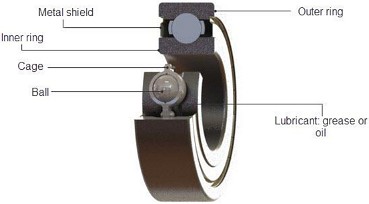For part I, click here
This week in the Bearings Blog, we’ll take a closer look into bearing in encoders, and mechanical specifications in particular. These specifications include runout, starting torque, running torque, maximum RPM, life versus speed/load, and shaft size.
Runout
Optical encoders offer mechanical stability and high precision with minimal shaft run out, often less than .001”. Typically, bearings of ABEC 3 precision are used to meet these requirements. Tighter runouts of .0005” are achieved using ABEC 5 or 7 bearings.
Loading
Generally, loads for industrial encoders are light, less than 50 pounds radial. This results in long life for the encoders. Smaller, radial ball bearings, up to 10 mm bore, are the most commonly used with encoders due to their high performance and versatility. Larger ball bearings, 12 mm or 5/8” bore are used in heavy duty encoders, which can be rated up to 200 G’s.
In applications utilizing gears or drive belts, such as conveyors used in numerous industries, there is often excessive side loading, which can shorten bearing life. In these situations the bearings can be spaced further apart within the enclosure. Increasing the center-to-center distance between bearings enables them to resist moment loading and greatly increases life. In most encoders, the bearings are mounted adjacent to one another with only a thin spacer between them. This allows for proper preloading and a compact, space saving design.
Other Bearing Types
Most manufacturers offer hollow shaft encoders. These provide another option for the mechanical coupling of the device via external clamping. These types of encoders use thin section ball bearings with their larger bore diameter, yet a thin cross section allows for a compact design. These bearings have moderate load and high speed capabilities.
Some designs utilize a single, double row ball bearing. This saves space, cost and simplifies the assembly process, but does not provide the same precise runout values as a preloaded pair of bearings. 10 mm bore is most common.
Encoders generally operate in the 3,000 to 12,000 RPM range which is ideally suited for all of these types of ball bearings.
Precision ball bearings easily meet the encoder manufacturer’s needs for low starting and running torque. These values can be as low as 1 inch-ounce and as high as 10 inch-ounces. The amount of preload applied to the bearings as part of the assembly process and the use of shaft seals on many enclosures contribute more to the torque values than the bearings themselves.
For part III, mounting preload, click here
Need assistance on bearing choices for encoders, or any other application? Our bearing experts and engineers are ready to help, contact them here.

